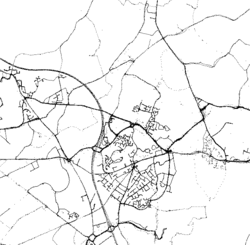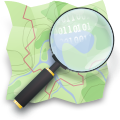OpenStreetMap
ផែនទីត្រូវបានបង្កើតឡើយដោយប្រើប្រាស់និន្នន័យពីឧបករណ៍ GPS ចល័ត, aerial photography, និងពីប្រភពសេរីឥតគិតថ្លៃនានា ឬពីចំណេះដឹង-ការដឹងលឺពីអ្នកមូលដ្ឋាន។ ទាំងរូបភាពផែនទី (rendered images) និងសំនុំទិន្នន័យវិុចទ័រ (vector dataset) គឺអាចទាញយកបាន ក្រោមអជ្ញាបណ្ណ Open Database License.[៤] The OpenStreetMap approach to mapping was inspired by sites such as Wikipedia;[៥] the map display features a prominent "Edit" link and a full revision history is maintained. Registered users can upload GPS track logs and edit the vector data using free GIS editing tools like JOSM.[៦] Various mobile applications also allow contribution of GPX tracks to the OSM project. ប្រវត្តិ  OpenStreetMap (OSM) ត្រូវបានបង្កើតឡើង នៅខែកក្កដា ២០០៤ ដោយលោក Steve Coast ។ នៅខែមេសា ២០០៦ មូលនិធិក OpenStreetMap Foundation (OSMF) ក៏ត្រូវបានបង្កើតឡើងដើម្បីជួយជំរុញនិងលើកទឹកចិត្តដល់ការរីកចំរើន អភិវឌ្ឍន៍ ក៏ដូចជាការចែកចាយនូវទិន្នន័យ geospatial សេរីឥតគិតថ្លៃ និងផ្ដល់ជូននូវទិន្នន័យទាំងនេះដល់អ្នកដែលចំណាប់អារម្មណ៍ដើម្បីប្រើប្រាស់ និងចែករំលែកបន្ត។ នៅខែធ្នូ ២០០៦ ក្រុមហ៊ុន Yahoo បានបញ្ជាក់ប្រាប់ឲ្យដឹងថា ខ្លួនបានអនុញ្ញាតឲ្យ OSM អាចប្រើប្រាស់ aerial photography របស់ខ្លួន ជាផ្ទាំងផ្ទៃខាងក្រោយសម្រាប់ការបង្កើត-គូរផែនទីបាន។[៧] នៅខែមេសា ២០០៧ Automotive Navigation Data (AND) បានបរិច្ចាគនូវសំនុំទិន្នន័យផ្លូវថ្នល់ទាំងស្រុងសម្រាប់ប្រទេស Netherlands និងទិន្នន័យផ្លូវ trunk road សម្រាប់ India និង China ទៅកាន់គម្រោង OSM[៨] and by July 2007, when the first OSM international The State of the Map conference was held, there were 9,000 registered users. Sponsors of the event included Google, Yahoo and Multimap. In October 2007, OpenStreetMap completed the import of a US Census TIGER road dataset.[៩] In December 2007, Oxford University became the first major organisation to use OpenStreetMap data on their main website.[១០] In January 2008, functionality was made available to download map data into a GPS unit for use by cyclists.[១១] In February 2008, a series of workshops were held in India.[១២] In March, two founders announced that they have received venture capital funding of 2.4M euros for CloudMade, a commercial company that will use OpenStreetMap data.[១៣] អ្នកប្រើប្រាស់ក្នុងរយៈពេលមួយដ៏ខ្លី មានអ្នកប្រើប្រាស់ដែលបានចុះឈ្មោះចូលរួមប្រមាណ ៥០ ០០០នាក់ បន្ទាប់ពីសន្និសិទ The State of the Map ត្រូវបានប្រារព្ធធ្វើឡើងនៅខែសីហា ឆ្នាំ២០០៨ ហើយក្រោយមកមានចំនួនអ្នកចុះឈ្មោះ ១០០ ០០០នាក់ នៅដើមឆ្នាំ២០០៩ និង ចំនួនប្រមាណជិត ២០០ ០០០នាក់នៅចុងឆ្នាំ ២០០៩។ លុះនៅខែមេសា ឆ្នាំ២០១២ OpenStreetMap បានធ្វើការលុបអ្នកដែលបានចុះឈ្មោះចំនួន ៦០០ ០០០នាក់វិញ។[១៤] ជាការពិត ក្នុងចំនោមអ្នកដែលបានចុះឈ្មោះដើម្បីចែករំលែកទិន្នន័យផែនទីទាំងអស់ មានចំនួនតិចតូចតែប៉ុណ្ណោះដែលបានធ្វើការផ្តល់នូវទិន្នន័យបានច្រើន។ នៅខែមិនាឆ្នាំ២០០៨ ចំនួនអ្នកប្រើប្រាស់ដែលបានចុះឈ្មោះ មានប្រមាណ ១០ភាគរយ បានចែករំលែកនូវទិន្នន័យផែនទី ជារៀងរាល់ខែ[១៥] និង នៅឆ្នាំ២០១១ ភាគរយបានថយចុះនៅសល់តែប្រមាណ ៣ភាគរយតែប៉ុណ្ណោះ[១៤] ។ ការផលិត-បង្កើតផែនទី TechniqueThe initial map data were collected from scratch by volunteers performing systematic ground surveys using a handheld GPS unit and a notebook, digital camera, or a voice recorder. These data were then entered into the OpenStreetMap database. More recently, the availability of aerial photography and other data sources from commercial and government sources has greatly increased the speed of this work and has allowed land-use data to be collected more accurately. When large datasets are available, a technical team manages the conversion and import of the data. Structured ground surveys   Ground surveys are performed by a mapper, on foot, bicycle or in a car or boat. Map data are usually collected using a GPS unit, although this is not strictly necessary if an area has already been traced from satellite imagery. Once the data has been collected, it is entered into the database by uploading it on the project's website. At that point in time, no information about the kind of uploaded track is available — it could be e.g. a motorway, a footpath or a river. Thus, in a second step, editing takes place using one of several purpose-built map editors. This is usually done by the same mapper, sometimes by other users registered at OpenStreetMap. As collecting and uploading data is separated from editing objects, contribution to the project is possible also without using a GPS unit. In particular, placing and editing objects such as schools, hospitals, taxi ranks, bus stops, pubs etc. is done based on editors' local knowledge. Some committed contributors are systematically mapping whole towns and cities over a period of time, or organising mapping parties to intensively map a particular area over an evening or a weekend. In addition to structured surveys, a large number of smaller edits are made by contributors to correct errors or add features. ប្រភពទិន្នន័យពីរដ្ឋាភិបាលSome government agencies have released official data on appropriate licenses. Much of this data has come from the United States, where the federal government does not copyright such data. See Copyright status of work by the U.S. government for more details.
Various authorities have also made more local detailed aerial photography available on suitable licenses through OpenAerialMap. Out-of-copyright maps can be good source of information about features that do not change frequently. Copyright periods vary, but in the UK, Crown copyright expires after 50 years and hence Ordnance Survey maps until the 1960s can legally be used. A complete set of UK 1 inch/mile maps from the late 1940s and early 1950s has been collected, scanned, and is available online as a resource for contributors. ប្រភពទិន្នន័យពីឯកជនSome commercial companies have donated data to the project on suitable licenses. Notably, Automotive Navigation Data provided a complete road data set for Netherlands and details of trunk roads in China and India. In December 2006, Yahoo! confirmed that OpenStreetMap was able to make use of their vertical aerial imagery and this photography was available within the editing software as an overlay. Contributors could create their vector based maps as a derived work, released with a free and open license,[៧] until the shutdown of the Yahoo! Maps API on September 13, 2011.[១៦] In November 2010, Microsoft announced that the OpenStreetMap community could use Bing vertical aerial imagery as a backdrop in its editors.[១៧] NearMap Pty Ltd have, since launch in November 2009, made their high-resolution PhotoMaps (currently of major Australian cities, plus some rural Australian areas) available for deriving OpenStreetMap data under a CC-BY-SA licence.[១៨] ការចេញអជ្ញាបណ្ណ The OpenStreetMap databaseOpenStreetMap data is published under an open content license, with the intention of promoting free use and re-distribution of the data (both commercial and non-commercial). The license currently used is the Open Database License.[៤] As part of this relicensing process, some of the map data will have to be deleted. This includes all data contributed by members who have not agreed to the new licensing terms, as well as all subsequent edits to those affected objects. It also includes any data contributed based on input data that are not compatible with the new terms. Current estimates suggest that over 97% of data will be retained globally, however certain regions will be affected more than others, such as in Australia where 24 to 84% of objects will be retained (depending on the type of object).[១៩] ទិន្នន័យបញ្ចូលAll data added to the project need to have a license compatible with the Creative Commons Attribution-Share Alike license. This can include out-of-copyright information, public domain or other licenses. All contributors must register with the project and agree to provide data on a Creative Commons BY-SA 2.0 licence, or determine that the licensing of the source data is suitable. This may involve examining licences for government data to establish whether they are compatible. This change in the licensing means that data added in future must be compatible with both the Open Database License and the new Contributor Terms in order to be accepted. កម្មវិធី SoftwareSoftware used in the production and presentation of OpenStreetMap data is available from many different projects and each may have their own licencing. The application — what users access to edit maps and view changelogs, is powered by Ruby on Rails. The application also uses PostgreSQL for storage of user data and edit metadata. The default map is rendered by Mapnik, stored in PostGIS, and powered by an Apache module called mod_tile. Certain parts of the software, such as the Flash-based map editor Potlatch2, have been made available as public domain.[២០] Derivations of OpenStreetMap Data OpenStreetMap is used as a data source for numerous other sites, that choose specific features of the data to highlight or remove, and provide features like higher performance and different aesthetics.
Off-line raster maps
Handheld GPS receivers
ទូរស័ព្ទដៃA wide variety of programs exist by now that use OpenStreetMap data to display maps on mobile phones,[២៤] supporting a large number of different devices. Amongst supported devices are nearly all phones that can run Java ME, making OpenStreetMap available to the majority of current phones, as well as platforms like Maemo, Android,[២៥] the iPhone,[២៦] Windows Mobile,[២៧] Blackberry, or Openmoko.[២៨] The various programs distinguish themselves according to key features like if they use raster maps or vector maps, need an Internet connection or can be used offline, support alternate render layers such as cycle paths,[២៩] support address search or advanced features like routing, thus catering for a large number of different needs for viewing maps. With the inclusion of OpenStreetMap support in several programming libraries for mobile phones,[៣០][៣១] it is also possible to include OSM maps in other location-based service. FlickrYahoo has started using OpenStreetMap data within its Flickr service for various cities around the world, including Baghdad, Beijing, Kabul, Santiago, Sydney and Tokyo.[៣២][៣៣][៣៤] FoursquareOn 29 February 2012, Foursquare started using OpenStreetMap maps.[៣៥] AppleWith the launch of iPhoto for iOS on 7 មីនា 2012 Apple Inc. started using OpenStreetMap data for photos with geolocation tags embedded. iPhoto for iOS 1.0.0 initially lacked OSM attribution. Later an updated version, 1.0.1, was released which contains the required OSM attribution.[៣៦] Blog/CMS IntegrationThe WordPress OpenStreetMap plug-in[៣៧] inserts maps and adds geo meta tags to posts / pages of WordPress blogs. Drupal has multiple OpenStreetMap plug-in modules[៣៨] to integrate database content with OpenStreetMaps. Joomla also has a variety of OpenStreetMap related modules[៣៩] and plug-ins.[៤០] ទិន្នន័យផែនទីMap data is available for download in a variety of formats and for different geographical areas: OSM provides information that other map sites don't provide: Monopoly City StreetsIn 2009, Hasbro, the games company behind the property trading board game Monopoly, launched Monopoly City Streets, a massively multiplayer online game which allowed players to "buy" streets all over the world. Although the game used map tiles from Google Maps and the Google Maps API to display the game board, the underlying vector street data was obtained from OpenStreetMap.[៤៤] The online game was meant to be a limited time offering, closing at the end of January 2010.[៤៥] Haiti earthquakeDuring the 2010 Haiti earthquake, OpenStreetMap and Crisis Commons volunteers used available satellite imagery[៤៦] to map the roads, buildings and refugee camps of Port-au-Prince in just two days, building "the most complete digital map of Haiti's roads".[៤៧] The resulting data and maps have been used by several organisations providing relief aid, such as the World Bank,[៤៨] the European Commission Joint Research Centre,[៤៩] the Office for the Coordination of Humanitarian Affairs,[៥០] UNOSAT[៥០] and others.[៥១] Software
Map rendering and presentation


Routing (directions, navigation)There are lists of online and offline routers available on the OSM wiki. Following routing software supports OpenStreetMaps:
ទម្រង់នៃទិន្នន័យCore elementsOpenStreetMap uses a topological data structure, with four core elements (also known as data primitives):
Up to version 0.4 of the protocol, an intermediate element between nodes and ways (segments, line segments which two node produced) was also used. Usage of elements
មើលផដដែរ
ឯកសារយោង
<ref> tag with name "ogd-Fairhurst" defined in <references> is not used in prior text.{{[[
អានបន្ថែម
តំណភ្ជាប់ខាងក្រៅ
|
||||||||||||||||||||||||||||||||||||||||||||||||||||||||||||||||||||||||||||||||||||||||||||||||||||||||||||||||||||||||
Portal di Ensiklopedia Dunia
















